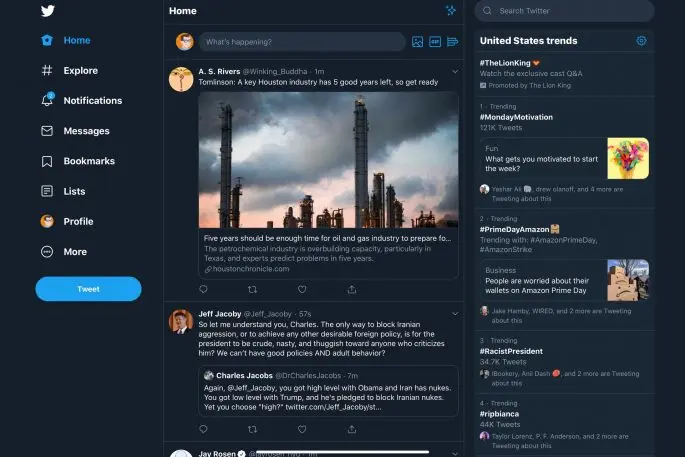On Tuesday, Twitter rolled out a new version of Twitter for those of us who use the service in a desktop browser. (The company has been testing the new look for awhile, so you may have already had it.)
The redesign is less about all-new features than cleaning up the existing experience and importing some functionality from the Twitter app. A new navigation menu along the left-hand side provides access to Explore (the topic-driven app feature now available on the web), direct messages, and more. The middle of the screen is devoted to whatever feature you’re using at the moment, with fewer interface quirks than in the old Twitter.com. You can now switch between multiple accounts on the fly. Oh, and there’s a dark mode, another option that originated in Twitter’s apps.

This new Twitter.com is cleaner and less disjointed than its predecessors, and I wouldn’t be surprised if enough people start using features they couldn’t find before to have made the upgrade worthwhile for the company. But as someone who knew my way around the old version, the new navigation—which fills about 20% of the screen with jumbo-sized menu items and an ocean of white space—feels like training wheels I don’t need.
What I would welcome is the ability to edit my tweets after I’ve posted them, so I can fix the typos that creep in.
This is not an idiosyncratic request. Actually, plenty of people reflexively bring it up every time Twitter changes anything about its service.
https://twitter.com/darren_bell/status/1150080648813711360
Which led me to wonder: How long have people been asking for an edit button, and how much explaining has Twitter done about why it hasn’t implemented one?
Don’t hold me to this, but Twitter user @livia—one of the first few dozen people to join the service back in the spring of 2006—may be the first member ever to have wished she could edit a tweet, at least among those who have expressed the desire on Twitter itself. She did so two months into the service’s history, when it was still called “twttr” and the term “tweet” had not yet been coined.
Wishing I could go back in twttr time to fix typos. Guess you can't take the editor outta the girl.
— Livia (@livia) May 24, 2006
Throughout 2006 and 2007, when Twitter was still in the process of becoming a phenomenon, other early adopters repeated her sentiment—often as a plaintive question rather than an angry demand. And the tweets about not being able to edit tweets have never subsided.
highly MOUSED because Twitter hasn't invented an 'edit' option yet!
— aimee rivers (@sermoa) December 4, 2006
Lamenting Twitter's lack of an 'edit' option. I should really learn to proof-read my posts. Wishing the word 'fid' read 'find' in my previous post. 😛
— K'in-Balam (@KinBalam) December 25, 2006
Wishing for the ability to edit tweets, for the umpteenth time.
— buzz@andersen.social (@buzz) November 27, 2007
Why is there no way to edit tweets? Now I have to delete them everytime I make a typo.
— Martijn Bleeker (@martijn_bleeker) September 28, 2007
And twitter doesn't let you edit your fat-thumbed iPhone tweets why?
— John Uhri (@y0mbo) December 10, 2007
https://twitter.com/DaveTheFuturist/status/18107179135401984
https://twitter.com/McThuggart/status/281937735042863105
When did Twitter’s lack of an edit button evolve from something Twitter users occasionally tweeted about into the emblematic example of the service not giving people something they wanted? I’m not sure. But in April 2013, Mat Honan—then of Wired—wrote an article titled “The One Feature Twitter Desperately Needs.” That feature was . . . well, you already know by now.
Instead of pitching an edit button as a cure for pesky typos, Hogan argued that it could be a vital tool in the war against misinformation. (Shortly before, he’d fallen for a bit of Twitter-borne fake news himself—tied to the Boston Marathon bombings—and unwittingly spread it.) He laid out how Twitter could implement such a feature in a way that would ensure people wouldn’t abuse it by using it in misleading ways.
By the way “you should be able to edit tweets” came out of a big, long, messy Twitter convo on Friday–@panzer really helped crystalize
— mat honan ☀️ (@mat) April 23, 2013
The following December, journalist Matthew Keys reported that the company was working on something that sounded much like Honan’s proposal, with much the same scenarios in mind. Though Keys’s sources called the feature a “top priority,” it never made it to production code.
In June 2015, Twitter cofounder Jack Dorsey once again became CEO. From then on, many of the users who tweeted about their yen to edit tweets directed the request to @jack himself rather than just shouting it into the void.
@jack pleeeeeeease help, i need to edit my tweets
— Mahmoud Mohamed (@Ma7moudMe) July 25, 2015
One user—@KimKardashian—did not tweet Dorsey. But her plea caught his attention,and he seemed downright enthusiastic about it.
@KimKardashian great idea! We're always looking at ways to make things faster and easier.
— jack (@jack) July 25, 2015
Once again, the fact that Twitter appreciated the usefulness of an edit button did not mean it wanted to do anything hasty. The company’s then-head of product, Kevin Weil, took time during a conference appearance to explain that Twitter didn’t want to add anything that might help people rewrite tweets after the fact with deception in mind.
Seventeen months later, editable tweets remained a user request rather than a feature. When Dorsey solicited ideas from users and summarized the results, he mentioned an editing option and pointed out the complexities it could raise.
Edit: clearest ask was to provide a quick way to fix errors. Anything beyond requires showing edit history given tweets are public record
— jack (@jack) December 30, 2016
By June 2018, Twitter still hadn’t introduced an edit button. (An August 2017 Financial Post story saying it was testing one was apparently a bug-induced false alarm.) But Kardashian—who is unafraid of taking crusades she cares about right to the top—had not given up. Unlike most Twitter users, she had the opportunity to pitch Dorsey in person.
I had a very good convo with @jack this weekend at Kanye’s bday and I think he really heard me out on the edit button.
— Kim Kardashian (@KimKardashian) June 13, 2018
Anyone who’s ever talked to Dorsey knows that he responds to just about anything you might say in a patient, contemplative fashion. (Disclosure: I have had a number of conversations with him over the years, and have never broached the subject of editing tweets, though it’s been tempting.) But Dorsey’s willingness to listen doesn’t mean that Twitter will rush to implement anything by popular demand. Unlike Facebook—which has had an edit option for years—Twitter has never had a culture that bragged about moving fast and breaking things. It’s quite happy to mull over its options indefinitely, until it comes up with a solution it finds pleasing.
And so it was no shocker that Dorsey did not give Kardashian her editing feature. Instead, as of December of last year, he was still talking thoughtfully about the gotchas Twitter had to confront as it attempted to do it “the right way.”
The fact that Twitter has spent this much time cheerfully refusing to give its most loyal users something they want so much does not strike me as a sign that it will ignore their pleas forever. After all, the company waited until it was almost 12 years old until it shattered its self-imposed 140-character limit. When it did, it turned out that the change had little impact other than saving all the time users had spent trying to cram their wordiest sentiments into the old character count.
An edit button, once it exists, might also be a smaller whoop than it would seem—-especially if Twitter designs it with quick typo correction in mind and/or makes it abundantly clear that a tweet has been edited since its initial posting. I still think we’ll get it someday. And if we do, it will be weird to experience a Twitter that’s devoid of tweets like this one:
I really wish i was able to edit my tweets
— monique (@moniquealexaaa) July 11, 2019
Recognize your brand’s excellence by applying to this year’s Brands That Matter Awards before the early-rate deadline, May 3.
